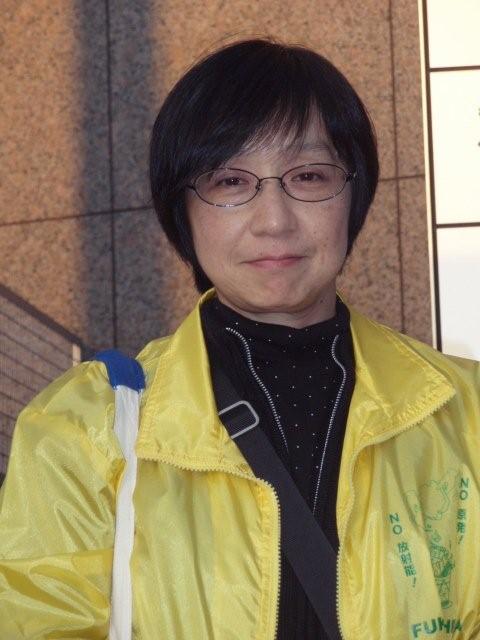 |
Dr. Katsumi Furitsu
|
Katsumi Furitsu is a quiet but strong-willed
medical doctor, devoting her life to the treatment of radiation victims
and participating in various campaigns for peace and a nuclear-free
society both at home and abroad. She is also a parttime lecturer
(genetics and basic medical radiology) at the Hyogo College of
Medicine. Dr. Furitsu is head of the secretariat of the Osaka-based
“Chernobyl Relief Group of Kansai,” and a member of the “Campaign
Against Radiation Exposure.” Since 2004, Dr. Furitsu has been a member
of the steering committee and science team of the “International
Coalition to Ban Uranium Weapons” (ICBUW), and since 2005, a member of
the “International Physicians for the Prevention of Nuclear War”
(IPPNW).
This year (2012), Dr. Furitsu received the Nuclear
Free Future Award (educational category) from the German-based Franz
Moll Foundation. This award is granted to individuals or groups
contributing to movements to create a nuclear-free world for future
generations. The award was given to Dr. Katsumi Furitsu in recognition
of her 30 years of work with the Japanese Hibakusha (atomic-bomb
survivors), and work to publicize radiation risks from nuclear power
plants, spent nuclear fuel reprocessing facilities and nuclear weapons.
Dr. Furitsu read a report about workers at nuclear
power plants when she was a student, and was greatly shocked by the
fact that the operation of the plants was based on the sacrifice of
socially vulnerable people. This prompted her to participate in the
anti-nuclear movement. After graduating from university, she worked at
the Hannan Chuo Hospital in Osaka as a physician and was engaged in the
treatment of radiation victims. At the same time, she took part in the
hospital’s project to examine the physical condition of 1,200 sufferers
of the atomic bombing of Hiroshima and Nagasaki who were living in
Osaka. The health checkups were conducted during the 1985-89 period. As
a result, she came to realize that, even 40 years after the bombing,
the patients were still suffering not only from damaged health but also
from social discrimination in terms of employment and marriage, anxiety
over radiation risks on their descendents, and other mental anguish.
The more she knew about their plight, the more she felt the need to
prevent such tragedies caused by radiation. Since then, she has
actively participated in campaigns against the construction and
operation of nuclear power plants in Fukui and Wakayama
Prefectures.
In the spring of 1991, Dr. Furitsu visited Belarus,
seriously affected by the Chernobyl nuclear catastrophe, and met local
residents, who were still suffering great hardship. After returning to
Japan, she organized the “Chernobyl Relief Group of Kansai” jointly
with her friends. This group is extending both material relief and
mental and emotional support to the residents in contaminated regions.
Group members visit the disaster area every year to offer medical
equipment and other supplies, and to provide local children with
financial assistance for medical treatment. Moreover, the group
occasionally invites victims to Japan, taking them to Hiroshima and
Fukui Prefecture, where many nuclear power plants are located. On those
occasions, they hold exchange meetings with local residents and
children. This year, the group invited a medical doctor and a teacher
from Belarus and held exchange meetings with sufferers of the Fukushima
nuclear
accident. Immediately after the Fukushima nuclear disaster, Dr. Katsumi
Furitsu rushed to Fukushima to provide local residents with advice on
how to reduce their exposure to radiation and to conduct an
investigation concerning residents’ health effects. Starting this year,
Dr. Furitsu is visiting Fukushima City once a month to give
health-related advice to local residents. She is frequently asked to
deliver lectures in Fukushima and her native Kansai region.
Dr. Furitsu flies to many parts of the world,
carrying a notebook PC with her. In 1992, she attended the World
Uranium Hearing held in Salzburg, and the second world conference on
nuclear radiation victims held in Berlin. In 1996, she participated in
the International Medical Commission on Chernobyl along with Dr.
Rosalie Bertell and her colleagues, and gave testimony at the Permanent
People's Tribunal Session on Chernobyl which was held in protest
against IAEA, which has greatly underestimated the human damage from
the Chernobyl nuclear accident. Furthermore, she visited several areas
affected by the impacts of the “nuclear chain,” including uranium mine
sites on Native American people’s land in the Southwest of the US, and
in the downwind area of the Nevada test site. She is still
communicating with the victims in those areas. Backed by a strong
anti-nuclear sentiment, she is working tirelessly for the sake of
socially disadvantaged radiation victims, and for me, she seems to be
the reincarnation of Dr. Rosalie Bertell.
*Citizens Against Nuclear Power
Plants, Takarazuka / Citizens for Renewable Energy Promotion, Takarazuka

